Newcomen atmospheric engine Cut Out Stock Images
(17)See newcomen atmospheric engine stock video clipsNewcomen atmospheric engine Cut Out Stock Images
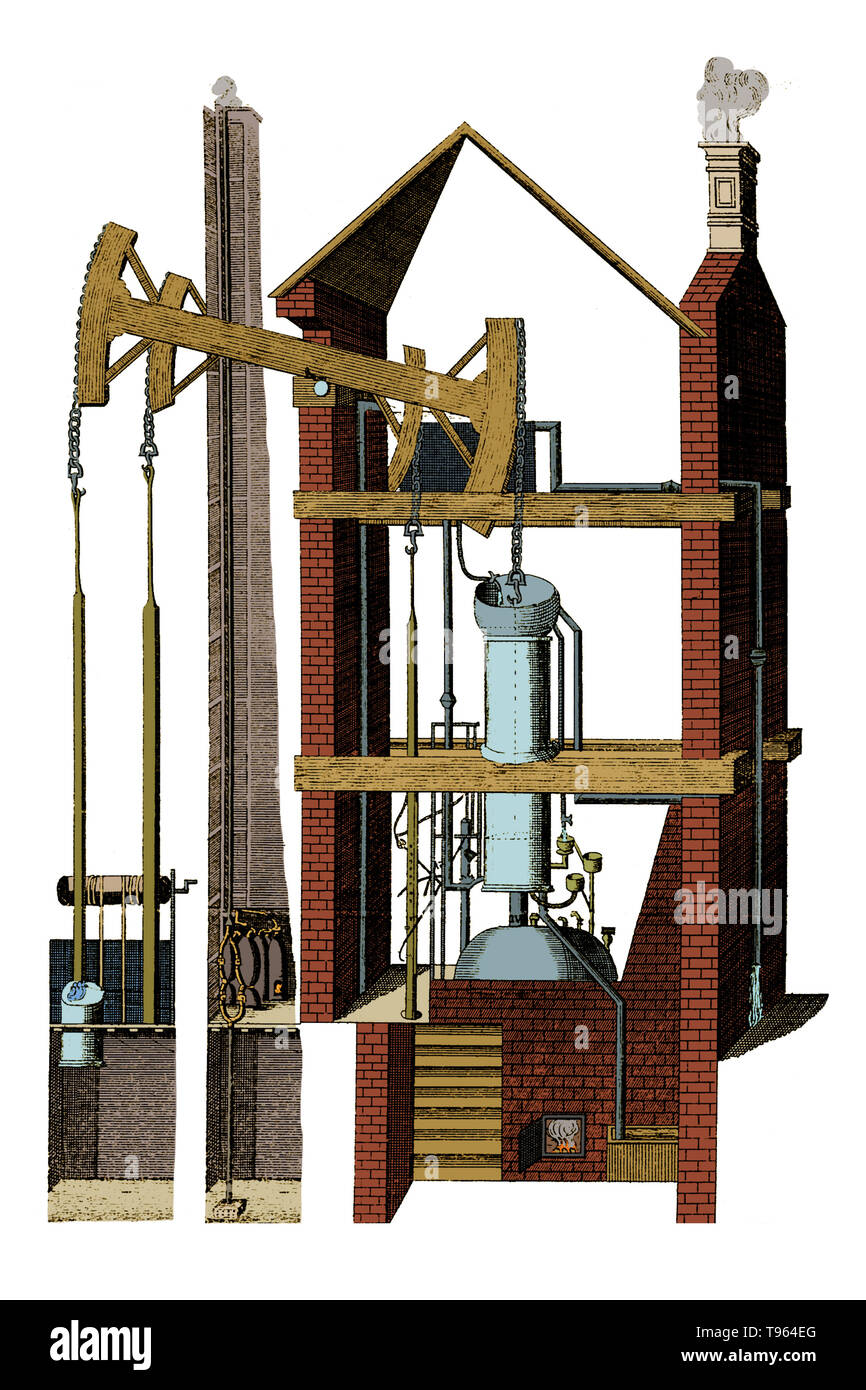 Engraving of a Newcomen steam-engine, c. 1747. Historical artwork of the steam engine patented by Thomas Newcomen (1663-1729) in 1705. The Newcomen atmospheric engine was the first to have a 'walking beam' pivoted arm (top) to transfer power between the piston and the rod. It was used to pump water out of coal mines. The piston was driven down by the pressure of a partial vacuum in the cylinder, causing the rod to be drawn upwards. As steam in the cylinder condensed the piston was forced up, and the rod forced down. This is the first true steam engine. Stock Photohttps://www.alamy.com/image-license-details/?v=1https://www.alamy.com/engraving-of-a-newcomen-steam-engine-c-1747-historical-artwork-of-the-steam-engine-patented-by-thomas-newcomen-1663-1729-in-1705-the-newcomen-atmospheric-engine-was-the-first-to-have-a-walking-beam-pivoted-arm-top-to-transfer-power-between-the-piston-and-the-rod-it-was-used-to-pump-water-out-of-coal-mines-the-piston-was-driven-down-by-the-pressure-of-a-partial-vacuum-in-the-cylinder-causing-the-rod-to-be-drawn-upwards-as-steam-in-the-cylinder-condensed-the-piston-was-forced-up-and-the-rod-forced-down-this-is-the-first-true-steam-engine-image246612312.html
Engraving of a Newcomen steam-engine, c. 1747. Historical artwork of the steam engine patented by Thomas Newcomen (1663-1729) in 1705. The Newcomen atmospheric engine was the first to have a 'walking beam' pivoted arm (top) to transfer power between the piston and the rod. It was used to pump water out of coal mines. The piston was driven down by the pressure of a partial vacuum in the cylinder, causing the rod to be drawn upwards. As steam in the cylinder condensed the piston was forced up, and the rod forced down. This is the first true steam engine. Stock Photohttps://www.alamy.com/image-license-details/?v=1https://www.alamy.com/engraving-of-a-newcomen-steam-engine-c-1747-historical-artwork-of-the-steam-engine-patented-by-thomas-newcomen-1663-1729-in-1705-the-newcomen-atmospheric-engine-was-the-first-to-have-a-walking-beam-pivoted-arm-top-to-transfer-power-between-the-piston-and-the-rod-it-was-used-to-pump-water-out-of-coal-mines-the-piston-was-driven-down-by-the-pressure-of-a-partial-vacuum-in-the-cylinder-causing-the-rod-to-be-drawn-upwards-as-steam-in-the-cylinder-condensed-the-piston-was-forced-up-and-the-rod-forced-down-this-is-the-first-true-steam-engine-image246612312.htmlRMT964EG–Engraving of a Newcomen steam-engine, c. 1747. Historical artwork of the steam engine patented by Thomas Newcomen (1663-1729) in 1705. The Newcomen atmospheric engine was the first to have a 'walking beam' pivoted arm (top) to transfer power between the piston and the rod. It was used to pump water out of coal mines. The piston was driven down by the pressure of a partial vacuum in the cylinder, causing the rod to be drawn upwards. As steam in the cylinder condensed the piston was forced up, and the rod forced down. This is the first true steam engine.
 Newcomen atmospheric engine (Heat Engines, 1913) Stock Photohttps://www.alamy.com/image-license-details/?v=1https://www.alamy.com/stock-photo-newcomen-atmospheric-engine-heat-engines-1913-140291259.html
Newcomen atmospheric engine (Heat Engines, 1913) Stock Photohttps://www.alamy.com/image-license-details/?v=1https://www.alamy.com/stock-photo-newcomen-atmospheric-engine-heat-engines-1913-140291259.htmlRMJ46PX3–Newcomen atmospheric engine (Heat Engines, 1913)
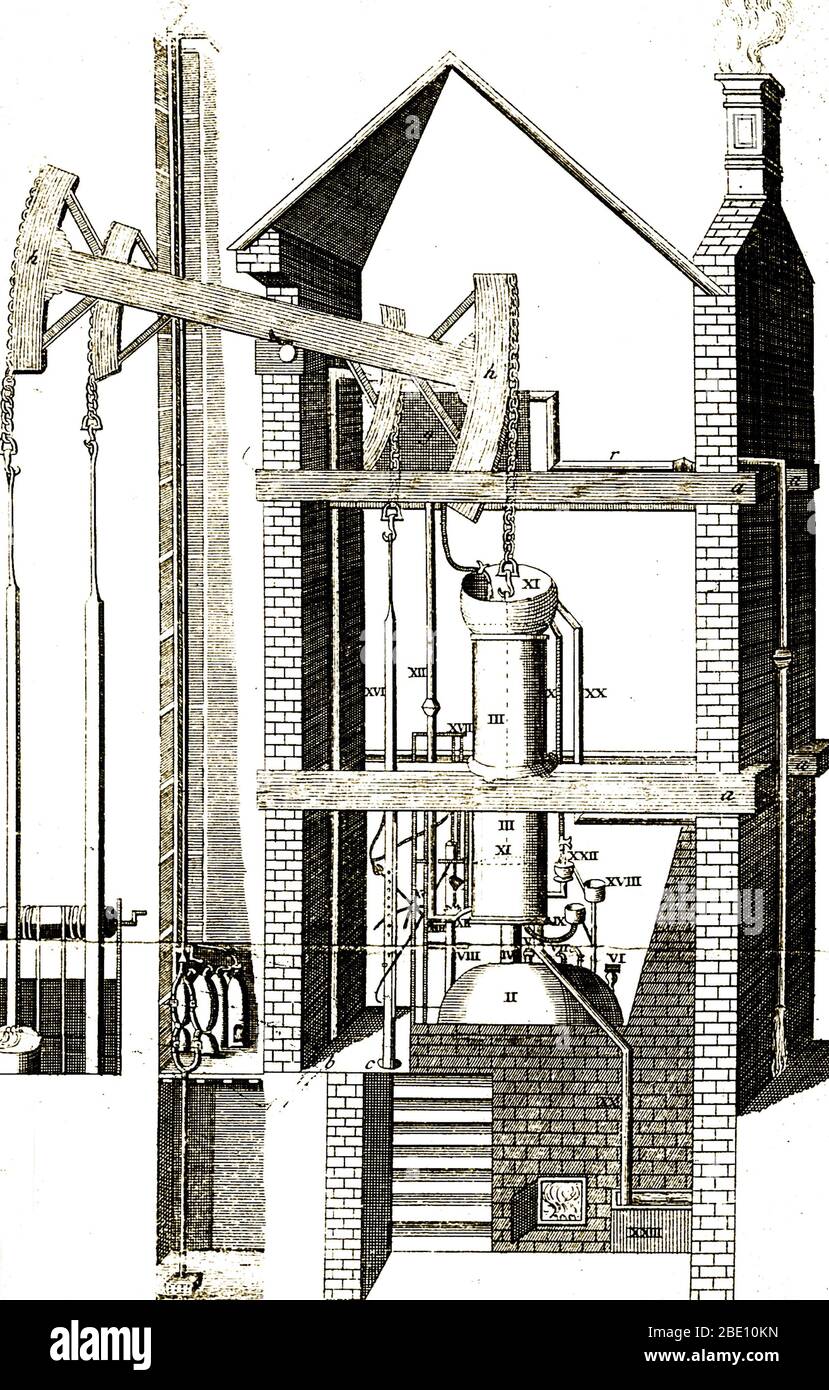 Engraving of a Newcomen steam-engine, c. 1747. Historical artwork of the steam engine patented by Thomas Newcomen (1663-1729) in 1705. The Newcomen atmospheric engine was the first to have a 'walking beam' pivoted arm (top) to transfer power between the piston and the rod. It was used to pump water out of coal mines. The piston was driven down by the pressure of a partial vacuum in the cylinder, causing the rod to be drawn upwards. As steam in the cylinder condensed the piston was forced up, and the rod forced down. This is the first true steam engine. Stock Photohttps://www.alamy.com/image-license-details/?v=1https://www.alamy.com/engraving-of-a-newcomen-steam-engine-c-1747-historical-artwork-of-the-steam-engine-patented-by-thomas-newcomen-1663-1729-in-1705-the-newcomen-atmospheric-engine-was-the-first-to-have-a-walking-beam-pivoted-arm-top-to-transfer-power-between-the-piston-and-the-rod-it-was-used-to-pump-water-out-of-coal-mines-the-piston-was-driven-down-by-the-pressure-of-a-partial-vacuum-in-the-cylinder-causing-the-rod-to-be-drawn-upwards-as-steam-in-the-cylinder-condensed-the-piston-was-forced-up-and-the-rod-forced-down-this-is-the-first-true-steam-engine-image352835049.html
Engraving of a Newcomen steam-engine, c. 1747. Historical artwork of the steam engine patented by Thomas Newcomen (1663-1729) in 1705. The Newcomen atmospheric engine was the first to have a 'walking beam' pivoted arm (top) to transfer power between the piston and the rod. It was used to pump water out of coal mines. The piston was driven down by the pressure of a partial vacuum in the cylinder, causing the rod to be drawn upwards. As steam in the cylinder condensed the piston was forced up, and the rod forced down. This is the first true steam engine. Stock Photohttps://www.alamy.com/image-license-details/?v=1https://www.alamy.com/engraving-of-a-newcomen-steam-engine-c-1747-historical-artwork-of-the-steam-engine-patented-by-thomas-newcomen-1663-1729-in-1705-the-newcomen-atmospheric-engine-was-the-first-to-have-a-walking-beam-pivoted-arm-top-to-transfer-power-between-the-piston-and-the-rod-it-was-used-to-pump-water-out-of-coal-mines-the-piston-was-driven-down-by-the-pressure-of-a-partial-vacuum-in-the-cylinder-causing-the-rod-to-be-drawn-upwards-as-steam-in-the-cylinder-condensed-the-piston-was-forced-up-and-the-rod-forced-down-this-is-the-first-true-steam-engine-image352835049.htmlRM2BE10KN–Engraving of a Newcomen steam-engine, c. 1747. Historical artwork of the steam engine patented by Thomas Newcomen (1663-1729) in 1705. The Newcomen atmospheric engine was the first to have a 'walking beam' pivoted arm (top) to transfer power between the piston and the rod. It was used to pump water out of coal mines. The piston was driven down by the pressure of a partial vacuum in the cylinder, causing the rod to be drawn upwards. As steam in the cylinder condensed the piston was forced up, and the rod forced down. This is the first true steam engine.
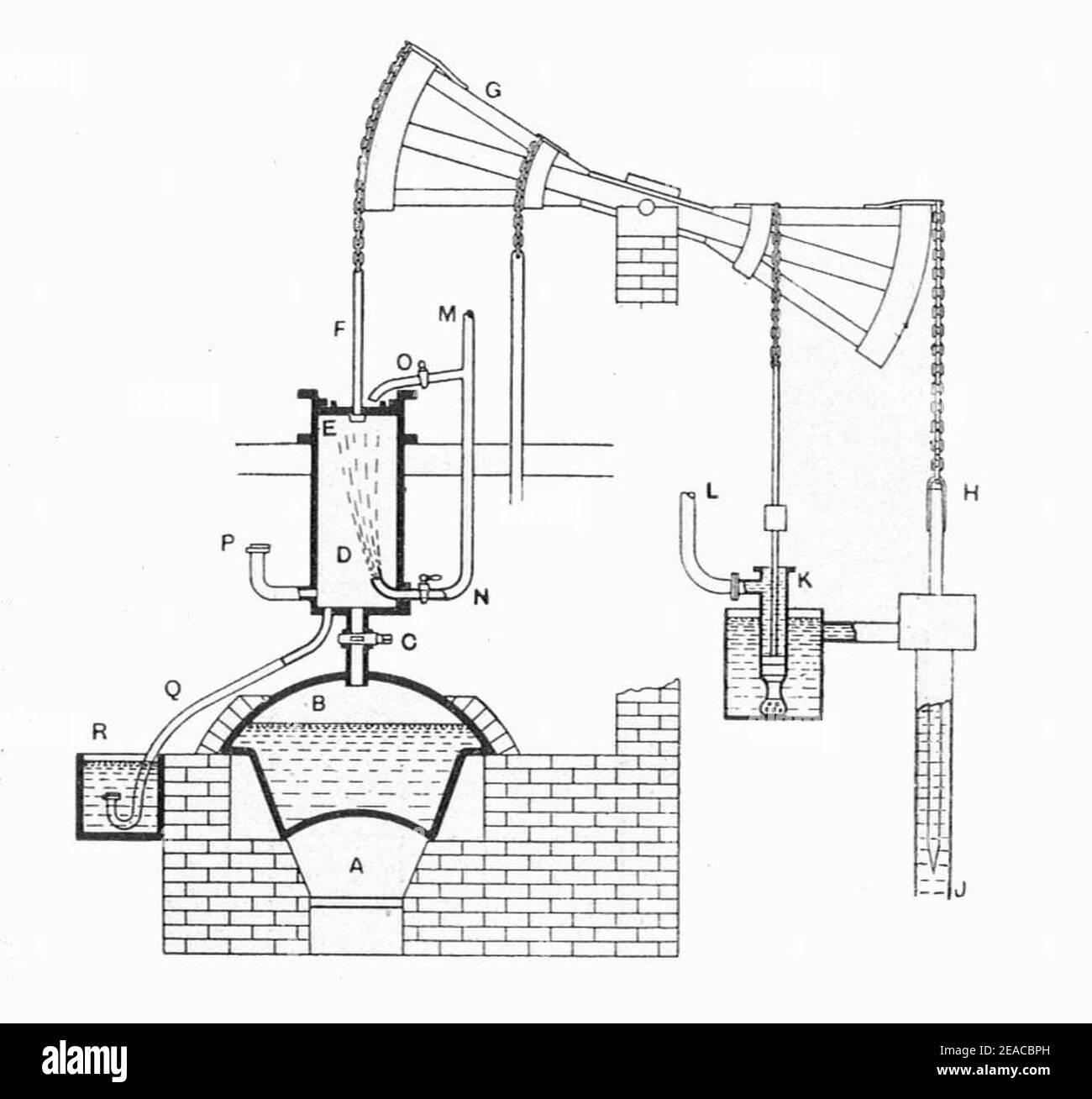 Newcomen atmospheric engine (Heat Engines, 1913). Stock Photohttps://www.alamy.com/image-license-details/?v=1https://www.alamy.com/newcomen-atmospheric-engine-heat-engines-1913-image402257705.html
Newcomen atmospheric engine (Heat Engines, 1913). Stock Photohttps://www.alamy.com/image-license-details/?v=1https://www.alamy.com/newcomen-atmospheric-engine-heat-engines-1913-image402257705.htmlRM2EACBPH–Newcomen atmospheric engine (Heat Engines, 1913).
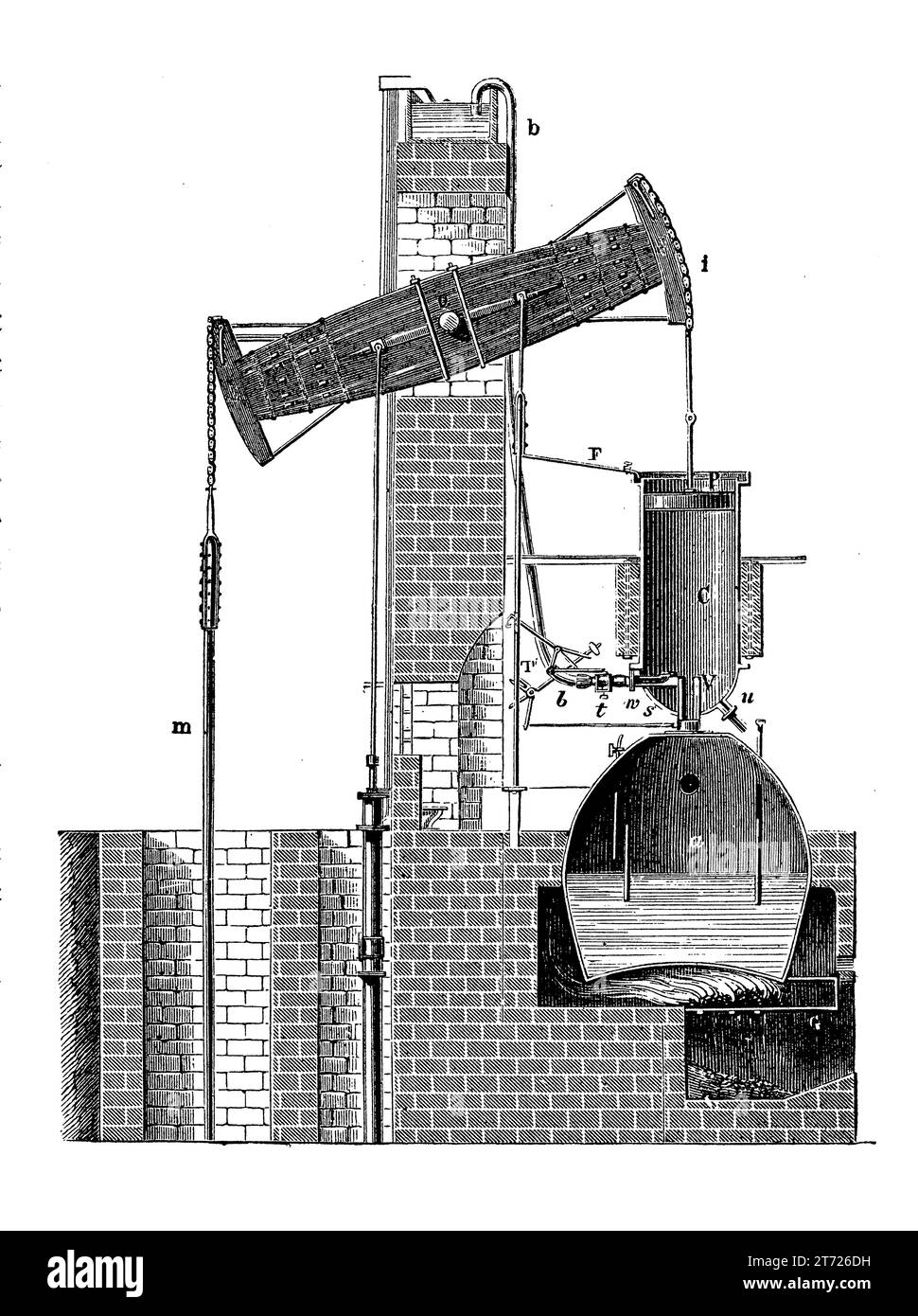 Atmospheric steam engine; invented by Thomas Newcomen in 1712 operating by condensing steam drawn into the cylinder to produce mechanical work; used principally to pump water out of mines Stock Photohttps://www.alamy.com/image-license-details/?v=1https://www.alamy.com/atmospheric-steam-engine-invented-by-thomas-newcomen-in-1712-operating-by-condensing-steam-drawn-into-the-cylinder-to-produce-mechanical-work-used-principally-to-pump-water-out-of-mines-image572293725.html
Atmospheric steam engine; invented by Thomas Newcomen in 1712 operating by condensing steam drawn into the cylinder to produce mechanical work; used principally to pump water out of mines Stock Photohttps://www.alamy.com/image-license-details/?v=1https://www.alamy.com/atmospheric-steam-engine-invented-by-thomas-newcomen-in-1712-operating-by-condensing-steam-drawn-into-the-cylinder-to-produce-mechanical-work-used-principally-to-pump-water-out-of-mines-image572293725.htmlRM2T726DH–Atmospheric steam engine; invented by Thomas Newcomen in 1712 operating by condensing steam drawn into the cylinder to produce mechanical work; used principally to pump water out of mines
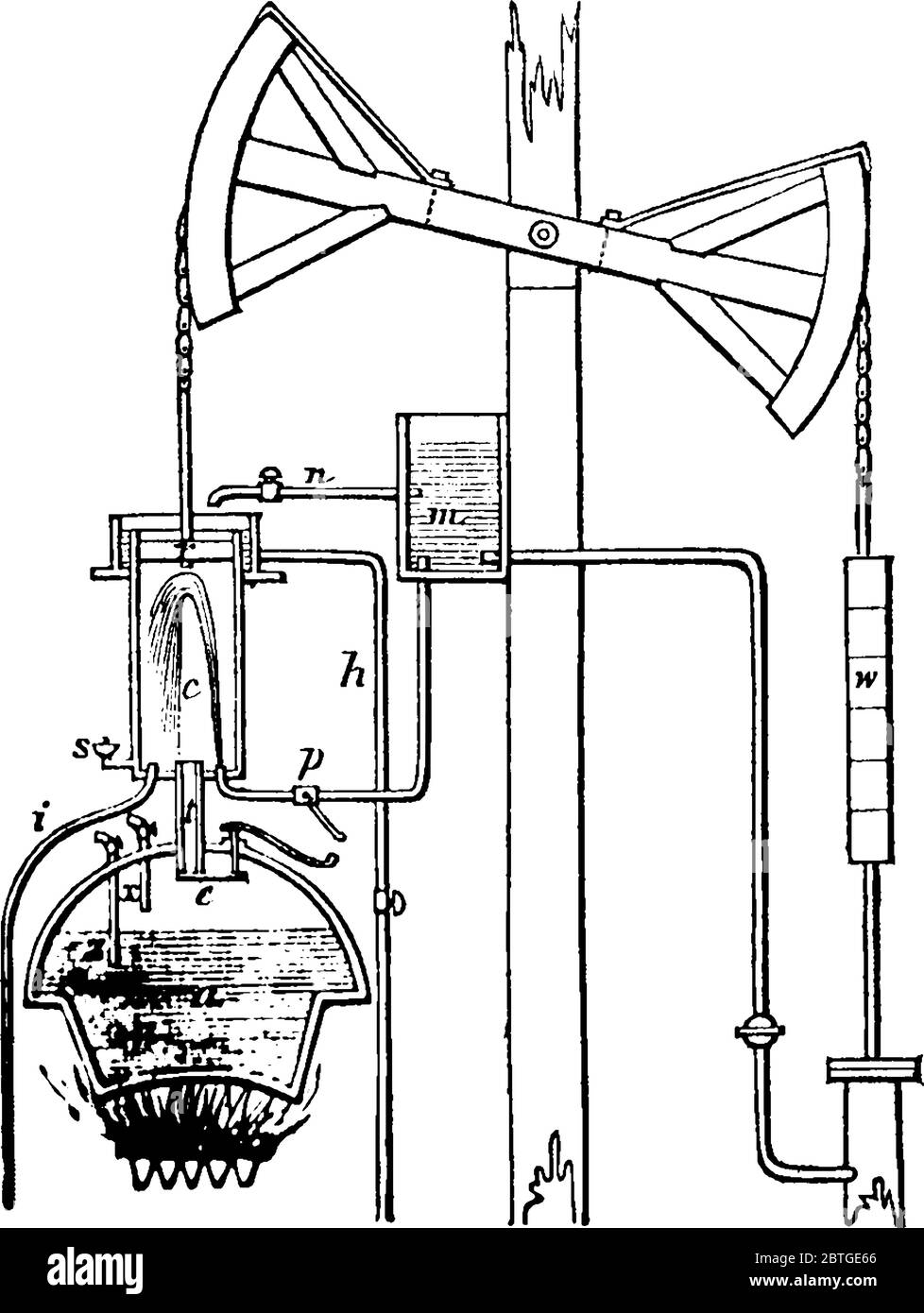 The Newcomen's Engine, the simple outline of the atmospheric engine, steam, 's', admitted from the boiler into the cylinder, through the tube, 'l', by Stock Vectorhttps://www.alamy.com/image-license-details/?v=1https://www.alamy.com/the-newcomens-engine-the-simple-outline-of-the-atmospheric-engine-steam-s-admitted-from-the-boiler-into-the-cylinder-through-the-tube-l-by-image359321486.html
The Newcomen's Engine, the simple outline of the atmospheric engine, steam, 's', admitted from the boiler into the cylinder, through the tube, 'l', by Stock Vectorhttps://www.alamy.com/image-license-details/?v=1https://www.alamy.com/the-newcomens-engine-the-simple-outline-of-the-atmospheric-engine-steam-s-admitted-from-the-boiler-into-the-cylinder-through-the-tube-l-by-image359321486.htmlRF2BTGE66–The Newcomen's Engine, the simple outline of the atmospheric engine, steam, 's', admitted from the boiler into the cylinder, through the tube, 'l', by
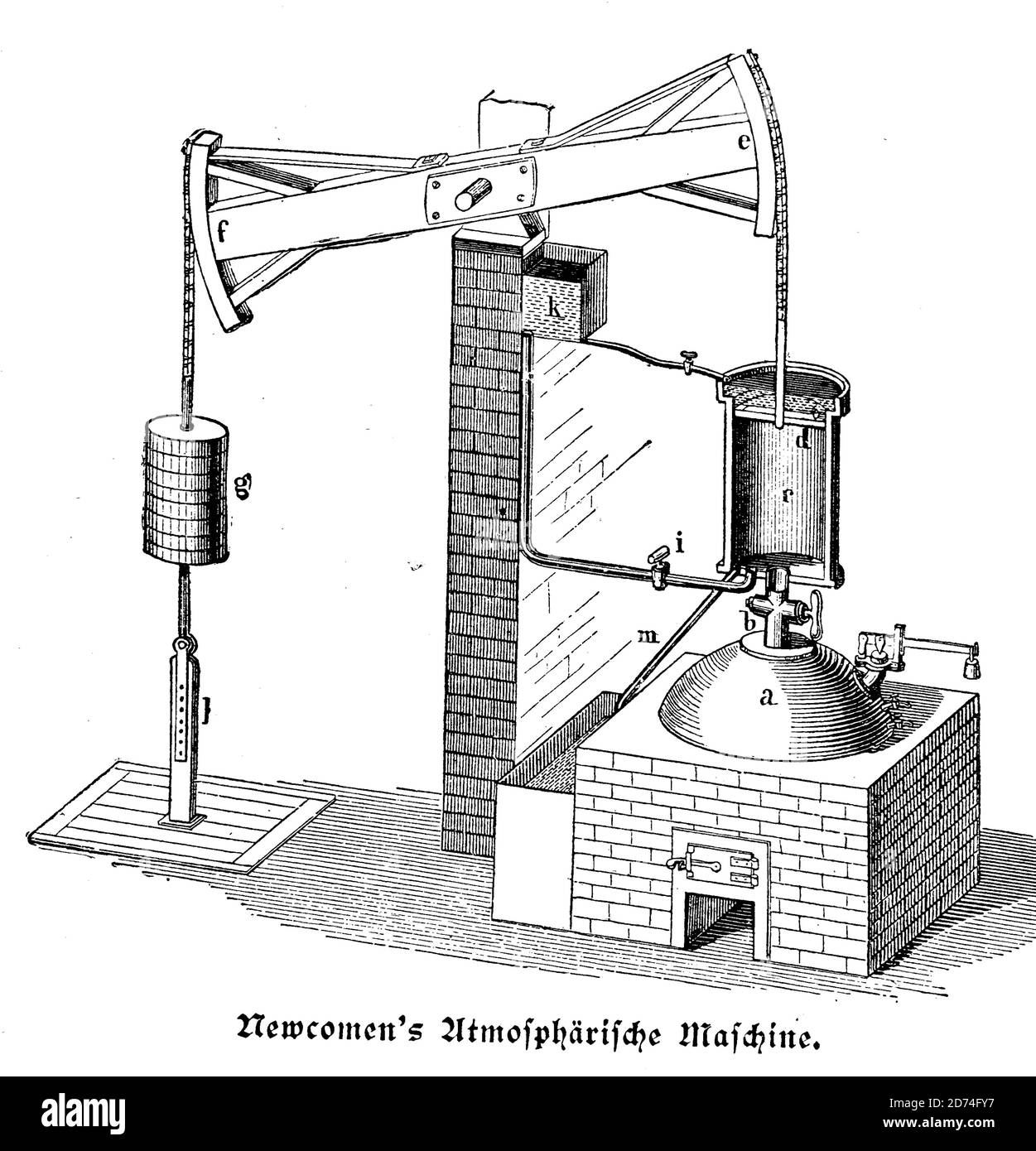 Atmospheric machine according Newcomen principle drawing of the steam engine human Newco / Atmosphärische Maschine nach Newcomen, Prinzipzeichnung der Newcomenschen Dampfmaschine, Historisch, historical, digital improved reproduction of an original from the 19th century / digitale Reproduktion einer Originalvorlage aus dem 19. Jahrhundert Stock Photohttps://www.alamy.com/image-license-details/?v=1https://www.alamy.com/atmospheric-machine-according-newcomen-principle-drawing-of-the-steam-engine-human-newco-atmosphrische-maschine-nach-newcomen-prinzipzeichnung-der-newcomenschen-dampfmaschine-historisch-historical-digital-improved-reproduction-of-an-original-from-the-19th-century-digitale-reproduktion-einer-originalvorlage-aus-dem-19-jahrhundert-image383031019.html
Atmospheric machine according Newcomen principle drawing of the steam engine human Newco / Atmosphärische Maschine nach Newcomen, Prinzipzeichnung der Newcomenschen Dampfmaschine, Historisch, historical, digital improved reproduction of an original from the 19th century / digitale Reproduktion einer Originalvorlage aus dem 19. Jahrhundert Stock Photohttps://www.alamy.com/image-license-details/?v=1https://www.alamy.com/atmospheric-machine-according-newcomen-principle-drawing-of-the-steam-engine-human-newco-atmosphrische-maschine-nach-newcomen-prinzipzeichnung-der-newcomenschen-dampfmaschine-historisch-historical-digital-improved-reproduction-of-an-original-from-the-19th-century-digitale-reproduktion-einer-originalvorlage-aus-dem-19-jahrhundert-image383031019.htmlRF2D74FY7–Atmospheric machine according Newcomen principle drawing of the steam engine human Newco / Atmosphärische Maschine nach Newcomen, Prinzipzeichnung der Newcomenschen Dampfmaschine, Historisch, historical, digital improved reproduction of an original from the 19th century / digitale Reproduktion einer Originalvorlage aus dem 19. Jahrhundert
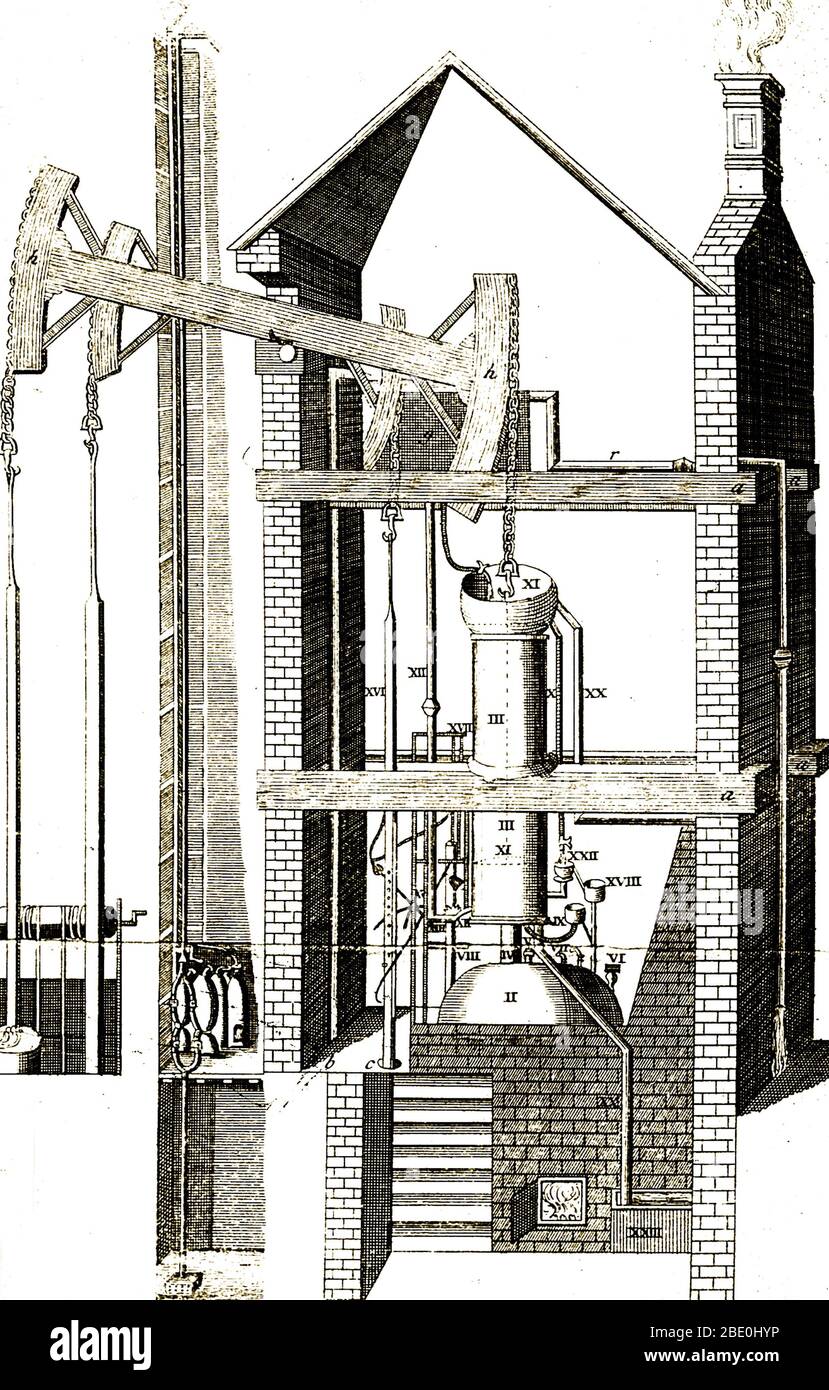 Engraving of a Newcomen steam-engine, c. 1747. Historical artwork of the steam engine patented by Thomas Newcomen (1663-1729) in 1705. The Newcomen atmospheric engine was the first to have a 'walking beam' pivoted arm (top) to transfer power between the piston and the rod. It was used to pump water out of coal mines. The piston was driven down by the pressure of a partial vacuum in the cylinder, causing the rod to be drawn upwards. As steam in the cylinder condensed the piston was forced up, and the rod forced down. This is the first true steam engine. Stock Photohttps://www.alamy.com/image-license-details/?v=1https://www.alamy.com/engraving-of-a-newcomen-steam-engine-c-1747-historical-artwork-of-the-steam-engine-patented-by-thomas-newcomen-1663-1729-in-1705-the-newcomen-atmospheric-engine-was-the-first-to-have-a-walking-beam-pivoted-arm-top-to-transfer-power-between-the-piston-and-the-rod-it-was-used-to-pump-water-out-of-coal-mines-the-piston-was-driven-down-by-the-pressure-of-a-partial-vacuum-in-the-cylinder-causing-the-rod-to-be-drawn-upwards-as-steam-in-the-cylinder-condensed-the-piston-was-forced-up-and-the-rod-forced-down-this-is-the-first-true-steam-engine-image352826650.html
Engraving of a Newcomen steam-engine, c. 1747. Historical artwork of the steam engine patented by Thomas Newcomen (1663-1729) in 1705. The Newcomen atmospheric engine was the first to have a 'walking beam' pivoted arm (top) to transfer power between the piston and the rod. It was used to pump water out of coal mines. The piston was driven down by the pressure of a partial vacuum in the cylinder, causing the rod to be drawn upwards. As steam in the cylinder condensed the piston was forced up, and the rod forced down. This is the first true steam engine. Stock Photohttps://www.alamy.com/image-license-details/?v=1https://www.alamy.com/engraving-of-a-newcomen-steam-engine-c-1747-historical-artwork-of-the-steam-engine-patented-by-thomas-newcomen-1663-1729-in-1705-the-newcomen-atmospheric-engine-was-the-first-to-have-a-walking-beam-pivoted-arm-top-to-transfer-power-between-the-piston-and-the-rod-it-was-used-to-pump-water-out-of-coal-mines-the-piston-was-driven-down-by-the-pressure-of-a-partial-vacuum-in-the-cylinder-causing-the-rod-to-be-drawn-upwards-as-steam-in-the-cylinder-condensed-the-piston-was-forced-up-and-the-rod-forced-down-this-is-the-first-true-steam-engine-image352826650.htmlRM2BE0HYP–Engraving of a Newcomen steam-engine, c. 1747. Historical artwork of the steam engine patented by Thomas Newcomen (1663-1729) in 1705. The Newcomen atmospheric engine was the first to have a 'walking beam' pivoted arm (top) to transfer power between the piston and the rod. It was used to pump water out of coal mines. The piston was driven down by the pressure of a partial vacuum in the cylinder, causing the rod to be drawn upwards. As steam in the cylinder condensed the piston was forced up, and the rod forced down. This is the first true steam engine.
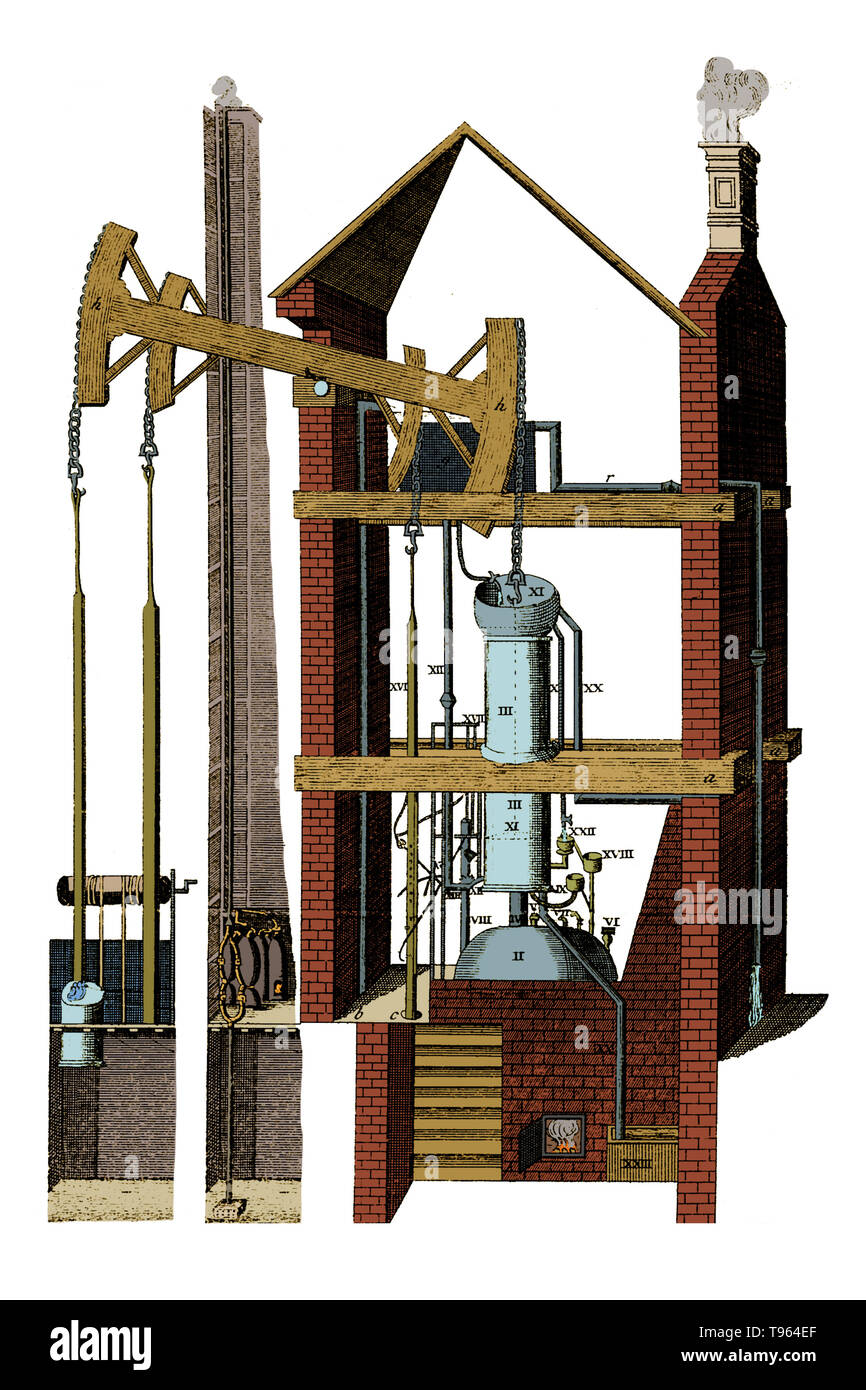 Engraving of a Newcomen steam-engine, c. 1747. Historical artwork of the steam engine patented by Thomas Newcomen (1663-1729) in 1705. The Newcomen atmospheric engine was the first to have a 'walking beam' pivoted arm (top) to transfer power between the piston and the rod. It was used to pump water out of coal mines. The piston was driven down by the pressure of a partial vacuum in the cylinder, causing the rod to be drawn upwards. As steam in the cylinder condensed the piston was forced up, and the rod forced down. This is the first true steam engine. Stock Photohttps://www.alamy.com/image-license-details/?v=1https://www.alamy.com/engraving-of-a-newcomen-steam-engine-c-1747-historical-artwork-of-the-steam-engine-patented-by-thomas-newcomen-1663-1729-in-1705-the-newcomen-atmospheric-engine-was-the-first-to-have-a-walking-beam-pivoted-arm-top-to-transfer-power-between-the-piston-and-the-rod-it-was-used-to-pump-water-out-of-coal-mines-the-piston-was-driven-down-by-the-pressure-of-a-partial-vacuum-in-the-cylinder-causing-the-rod-to-be-drawn-upwards-as-steam-in-the-cylinder-condensed-the-piston-was-forced-up-and-the-rod-forced-down-this-is-the-first-true-steam-engine-image246612311.html
Engraving of a Newcomen steam-engine, c. 1747. Historical artwork of the steam engine patented by Thomas Newcomen (1663-1729) in 1705. The Newcomen atmospheric engine was the first to have a 'walking beam' pivoted arm (top) to transfer power between the piston and the rod. It was used to pump water out of coal mines. The piston was driven down by the pressure of a partial vacuum in the cylinder, causing the rod to be drawn upwards. As steam in the cylinder condensed the piston was forced up, and the rod forced down. This is the first true steam engine. Stock Photohttps://www.alamy.com/image-license-details/?v=1https://www.alamy.com/engraving-of-a-newcomen-steam-engine-c-1747-historical-artwork-of-the-steam-engine-patented-by-thomas-newcomen-1663-1729-in-1705-the-newcomen-atmospheric-engine-was-the-first-to-have-a-walking-beam-pivoted-arm-top-to-transfer-power-between-the-piston-and-the-rod-it-was-used-to-pump-water-out-of-coal-mines-the-piston-was-driven-down-by-the-pressure-of-a-partial-vacuum-in-the-cylinder-causing-the-rod-to-be-drawn-upwards-as-steam-in-the-cylinder-condensed-the-piston-was-forced-up-and-the-rod-forced-down-this-is-the-first-true-steam-engine-image246612311.htmlRMT964EF–Engraving of a Newcomen steam-engine, c. 1747. Historical artwork of the steam engine patented by Thomas Newcomen (1663-1729) in 1705. The Newcomen atmospheric engine was the first to have a 'walking beam' pivoted arm (top) to transfer power between the piston and the rod. It was used to pump water out of coal mines. The piston was driven down by the pressure of a partial vacuum in the cylinder, causing the rod to be drawn upwards. As steam in the cylinder condensed the piston was forced up, and the rod forced down. This is the first true steam engine.
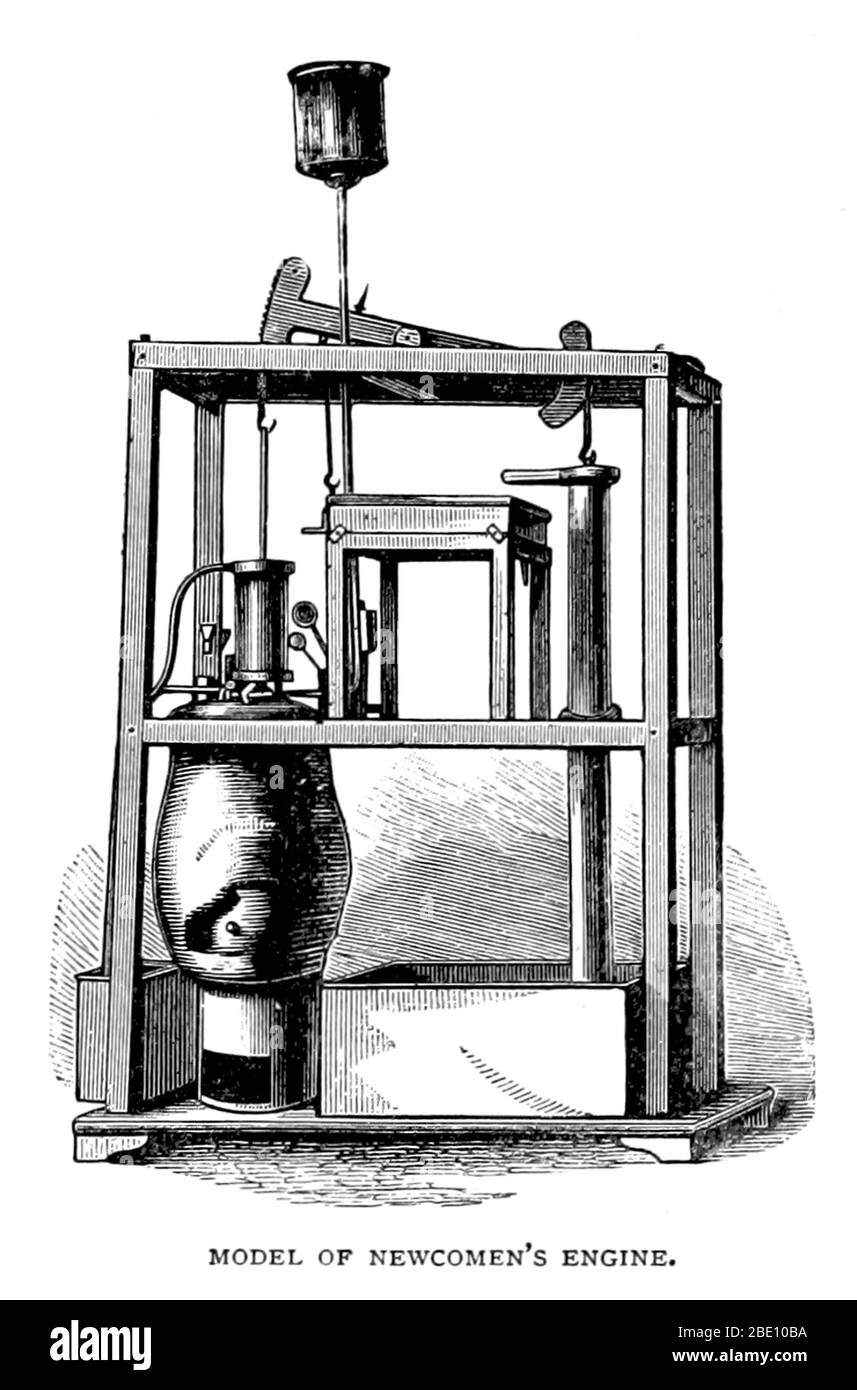 The atmospheric engine invented by Thomas Newcomen in 1712, often referred to simply as a Newcomen engine, was the first practical device to harness the power of steam to produce mechanical work. Newcomen engines were used throughout Britain and Europe, principally to pump water out of mines, starting in the early 18th century. James Watt's later Watt steam engine was an improved version of the Newcomen engine. As a result, Watt is today better known than Newcomen in relation to the origin of the steam engine. Thomas Newcomen (February 1664 - August 5, 1729) was an English inventor, ironmonger Stock Photohttps://www.alamy.com/image-license-details/?v=1https://www.alamy.com/the-atmospheric-engine-invented-by-thomas-newcomen-in-1712-often-referred-to-simply-as-a-newcomen-engine-was-the-first-practical-device-to-harness-the-power-of-steam-to-produce-mechanical-work-newcomen-engines-were-used-throughout-britain-and-europe-principally-to-pump-water-out-of-mines-starting-in-the-early-18th-century-james-watts-later-watt-steam-engine-was-an-improved-version-of-the-newcomen-engine-as-a-result-watt-is-today-better-known-than-newcomen-in-relation-to-the-origin-of-the-steam-engine-thomas-newcomen-february-1664-august-5-1729-was-an-english-inventor-ironmonger-image352834814.html
The atmospheric engine invented by Thomas Newcomen in 1712, often referred to simply as a Newcomen engine, was the first practical device to harness the power of steam to produce mechanical work. Newcomen engines were used throughout Britain and Europe, principally to pump water out of mines, starting in the early 18th century. James Watt's later Watt steam engine was an improved version of the Newcomen engine. As a result, Watt is today better known than Newcomen in relation to the origin of the steam engine. Thomas Newcomen (February 1664 - August 5, 1729) was an English inventor, ironmonger Stock Photohttps://www.alamy.com/image-license-details/?v=1https://www.alamy.com/the-atmospheric-engine-invented-by-thomas-newcomen-in-1712-often-referred-to-simply-as-a-newcomen-engine-was-the-first-practical-device-to-harness-the-power-of-steam-to-produce-mechanical-work-newcomen-engines-were-used-throughout-britain-and-europe-principally-to-pump-water-out-of-mines-starting-in-the-early-18th-century-james-watts-later-watt-steam-engine-was-an-improved-version-of-the-newcomen-engine-as-a-result-watt-is-today-better-known-than-newcomen-in-relation-to-the-origin-of-the-steam-engine-thomas-newcomen-february-1664-august-5-1729-was-an-english-inventor-ironmonger-image352834814.htmlRM2BE10BA–The atmospheric engine invented by Thomas Newcomen in 1712, often referred to simply as a Newcomen engine, was the first practical device to harness the power of steam to produce mechanical work. Newcomen engines were used throughout Britain and Europe, principally to pump water out of mines, starting in the early 18th century. James Watt's later Watt steam engine was an improved version of the Newcomen engine. As a result, Watt is today better known than Newcomen in relation to the origin of the steam engine. Thomas Newcomen (February 1664 - August 5, 1729) was an English inventor, ironmonger
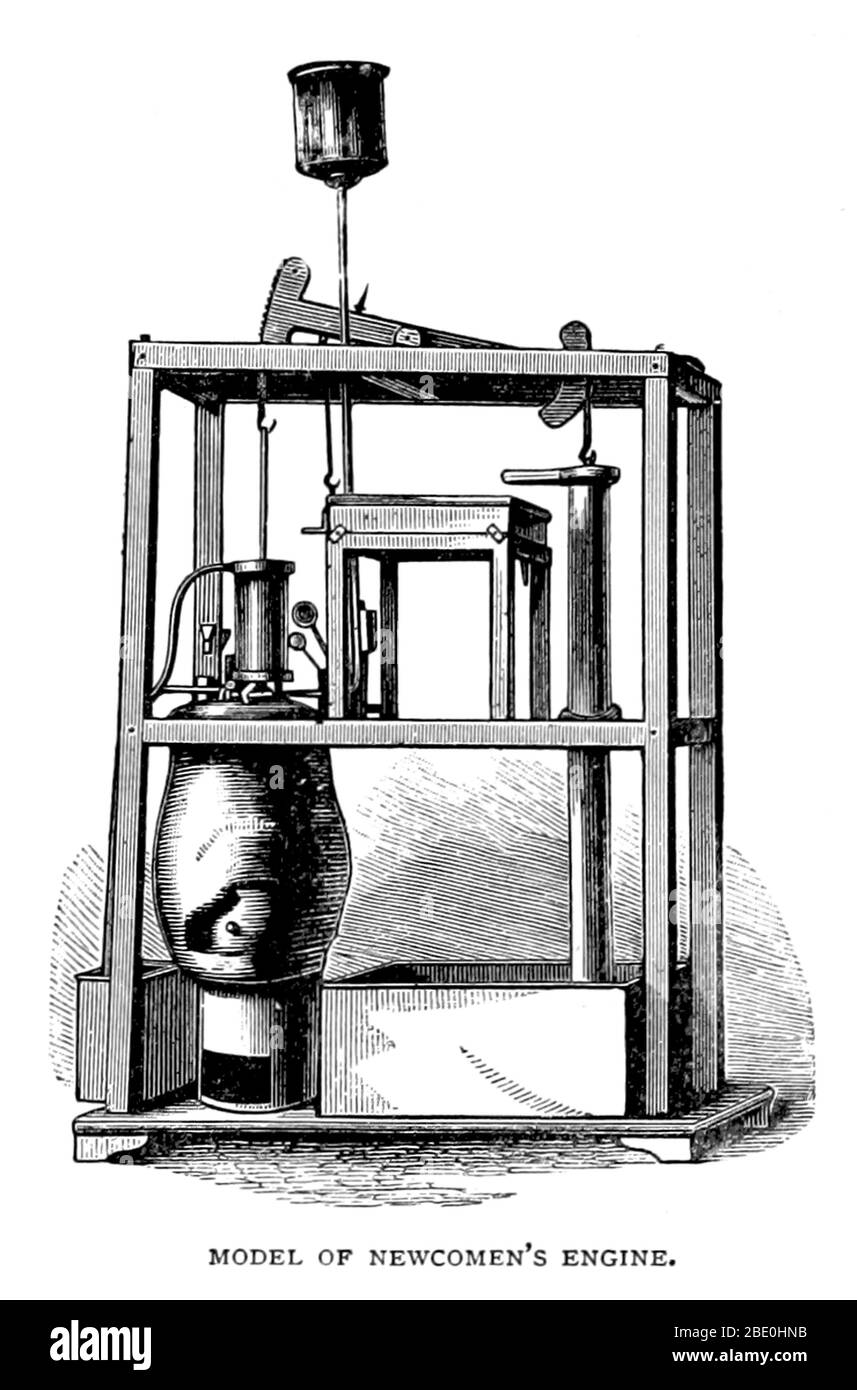 The atmospheric engine invented by Thomas Newcomen in 1712, often referred to simply as a Newcomen engine, was the first practical device to harness the power of steam to produce mechanical work. Newcomen engines were used throughout Britain and Europe, principally to pump water out of mines, starting in the early 18th century. James Watt's later Watt steam engine was an improved version of the Newcomen engine. As a result, Watt is today better known than Newcomen in relation to the origin of the steam engine. Thomas Newcomen (February 1664 - August 5, 1729) was an English inventor, ironmonger Stock Photohttps://www.alamy.com/image-license-details/?v=1https://www.alamy.com/the-atmospheric-engine-invented-by-thomas-newcomen-in-1712-often-referred-to-simply-as-a-newcomen-engine-was-the-first-practical-device-to-harness-the-power-of-steam-to-produce-mechanical-work-newcomen-engines-were-used-throughout-britain-and-europe-principally-to-pump-water-out-of-mines-starting-in-the-early-18th-century-james-watts-later-watt-steam-engine-was-an-improved-version-of-the-newcomen-engine-as-a-result-watt-is-today-better-known-than-newcomen-in-relation-to-the-origin-of-the-steam-engine-thomas-newcomen-february-1664-august-5-1729-was-an-english-inventor-ironmonger-image352826471.html
The atmospheric engine invented by Thomas Newcomen in 1712, often referred to simply as a Newcomen engine, was the first practical device to harness the power of steam to produce mechanical work. Newcomen engines were used throughout Britain and Europe, principally to pump water out of mines, starting in the early 18th century. James Watt's later Watt steam engine was an improved version of the Newcomen engine. As a result, Watt is today better known than Newcomen in relation to the origin of the steam engine. Thomas Newcomen (February 1664 - August 5, 1729) was an English inventor, ironmonger Stock Photohttps://www.alamy.com/image-license-details/?v=1https://www.alamy.com/the-atmospheric-engine-invented-by-thomas-newcomen-in-1712-often-referred-to-simply-as-a-newcomen-engine-was-the-first-practical-device-to-harness-the-power-of-steam-to-produce-mechanical-work-newcomen-engines-were-used-throughout-britain-and-europe-principally-to-pump-water-out-of-mines-starting-in-the-early-18th-century-james-watts-later-watt-steam-engine-was-an-improved-version-of-the-newcomen-engine-as-a-result-watt-is-today-better-known-than-newcomen-in-relation-to-the-origin-of-the-steam-engine-thomas-newcomen-february-1664-august-5-1729-was-an-english-inventor-ironmonger-image352826471.htmlRM2BE0HNB–The atmospheric engine invented by Thomas Newcomen in 1712, often referred to simply as a Newcomen engine, was the first practical device to harness the power of steam to produce mechanical work. Newcomen engines were used throughout Britain and Europe, principally to pump water out of mines, starting in the early 18th century. James Watt's later Watt steam engine was an improved version of the Newcomen engine. As a result, Watt is today better known than Newcomen in relation to the origin of the steam engine. Thomas Newcomen (February 1664 - August 5, 1729) was an English inventor, ironmonger
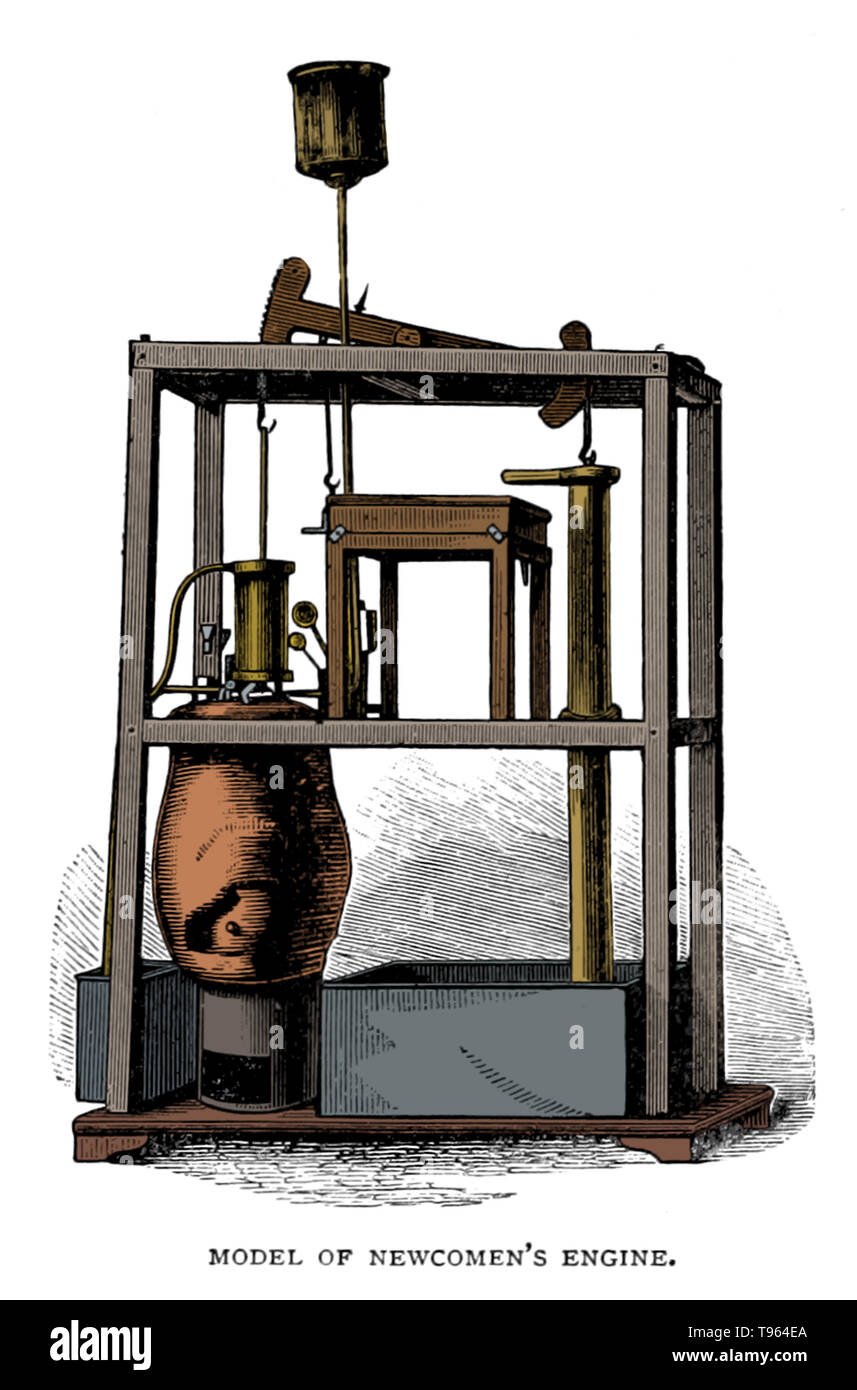 Illustration of Newcomen's steam engine taken from page 112 of 'George Square, Glasgow; and the lives of those whom its statues commemorate, etc' by Thomas (of Glascow) Somerville, 1891. The atmospheric engine invented by Thomas Newcomen in 1712, often referred to simply as a Newcomen engine, was the first practical device to harness the power of steam to produce mechanical work. Stock Photohttps://www.alamy.com/image-license-details/?v=1https://www.alamy.com/illustration-of-newcomens-steam-engine-taken-from-page-112-of-george-square-glasgow-and-the-lives-of-those-whom-its-statues-commemorate-etc-by-thomas-of-glascow-somerville-1891-the-atmospheric-engine-invented-by-thomas-newcomen-in-1712-often-referred-to-simply-as-a-newcomen-engine-was-the-first-practical-device-to-harness-the-power-of-steam-to-produce-mechanical-work-image246612306.html
Illustration of Newcomen's steam engine taken from page 112 of 'George Square, Glasgow; and the lives of those whom its statues commemorate, etc' by Thomas (of Glascow) Somerville, 1891. The atmospheric engine invented by Thomas Newcomen in 1712, often referred to simply as a Newcomen engine, was the first practical device to harness the power of steam to produce mechanical work. Stock Photohttps://www.alamy.com/image-license-details/?v=1https://www.alamy.com/illustration-of-newcomens-steam-engine-taken-from-page-112-of-george-square-glasgow-and-the-lives-of-those-whom-its-statues-commemorate-etc-by-thomas-of-glascow-somerville-1891-the-atmospheric-engine-invented-by-thomas-newcomen-in-1712-often-referred-to-simply-as-a-newcomen-engine-was-the-first-practical-device-to-harness-the-power-of-steam-to-produce-mechanical-work-image246612306.htmlRMT964EA–Illustration of Newcomen's steam engine taken from page 112 of 'George Square, Glasgow; and the lives of those whom its statues commemorate, etc' by Thomas (of Glascow) Somerville, 1891. The atmospheric engine invented by Thomas Newcomen in 1712, often referred to simply as a Newcomen engine, was the first practical device to harness the power of steam to produce mechanical work.
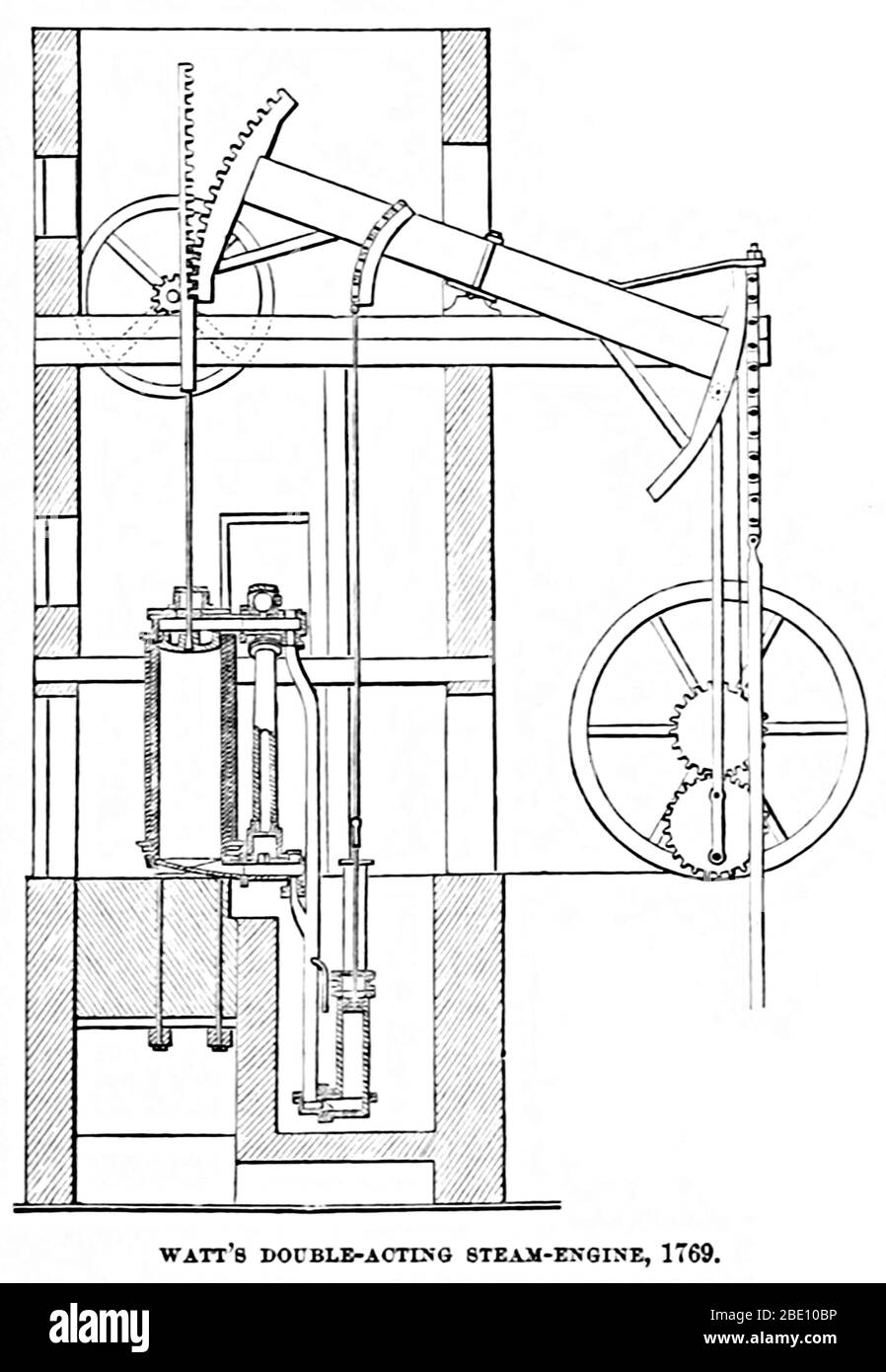 Watts' Double-acting steam engine. The Watt steam engine (alternatively known as the Boulton and Watt steam engine) was the first type of steam engine to make use of steam at a pressure just above atmospheric to drive the piston helped by a partial vacuum. Improving on the design of the 1712 Newcomen engine, the Watt steam engine, developed sporadically from 1763 to 1775, was the next great step in the development of the steam engine. Watt's two most important improvements were the separate condenser and rotary motion. Illustration from A review of American progress by Theodore Dwight Woolsey, Stock Photohttps://www.alamy.com/image-license-details/?v=1https://www.alamy.com/watts-double-acting-steam-engine-the-watt-steam-engine-alternatively-known-as-the-boulton-and-watt-steam-engine-was-the-first-type-of-steam-engine-to-make-use-of-steam-at-a-pressure-just-above-atmospheric-to-drive-the-piston-helped-by-a-partial-vacuum-improving-on-the-design-of-the-1712-newcomen-engine-the-watt-steam-engine-developed-sporadically-from-1763-to-1775-was-the-next-great-step-in-the-development-of-the-steam-engine-watts-two-most-important-improvements-were-the-separate-condenser-and-rotary-motion-illustration-from-a-review-of-american-progress-by-theodore-dwight-woolsey-image352834826.html
Watts' Double-acting steam engine. The Watt steam engine (alternatively known as the Boulton and Watt steam engine) was the first type of steam engine to make use of steam at a pressure just above atmospheric to drive the piston helped by a partial vacuum. Improving on the design of the 1712 Newcomen engine, the Watt steam engine, developed sporadically from 1763 to 1775, was the next great step in the development of the steam engine. Watt's two most important improvements were the separate condenser and rotary motion. Illustration from A review of American progress by Theodore Dwight Woolsey, Stock Photohttps://www.alamy.com/image-license-details/?v=1https://www.alamy.com/watts-double-acting-steam-engine-the-watt-steam-engine-alternatively-known-as-the-boulton-and-watt-steam-engine-was-the-first-type-of-steam-engine-to-make-use-of-steam-at-a-pressure-just-above-atmospheric-to-drive-the-piston-helped-by-a-partial-vacuum-improving-on-the-design-of-the-1712-newcomen-engine-the-watt-steam-engine-developed-sporadically-from-1763-to-1775-was-the-next-great-step-in-the-development-of-the-steam-engine-watts-two-most-important-improvements-were-the-separate-condenser-and-rotary-motion-illustration-from-a-review-of-american-progress-by-theodore-dwight-woolsey-image352834826.htmlRM2BE10BP–Watts' Double-acting steam engine. The Watt steam engine (alternatively known as the Boulton and Watt steam engine) was the first type of steam engine to make use of steam at a pressure just above atmospheric to drive the piston helped by a partial vacuum. Improving on the design of the 1712 Newcomen engine, the Watt steam engine, developed sporadically from 1763 to 1775, was the next great step in the development of the steam engine. Watt's two most important improvements were the separate condenser and rotary motion. Illustration from A review of American progress by Theodore Dwight Woolsey,
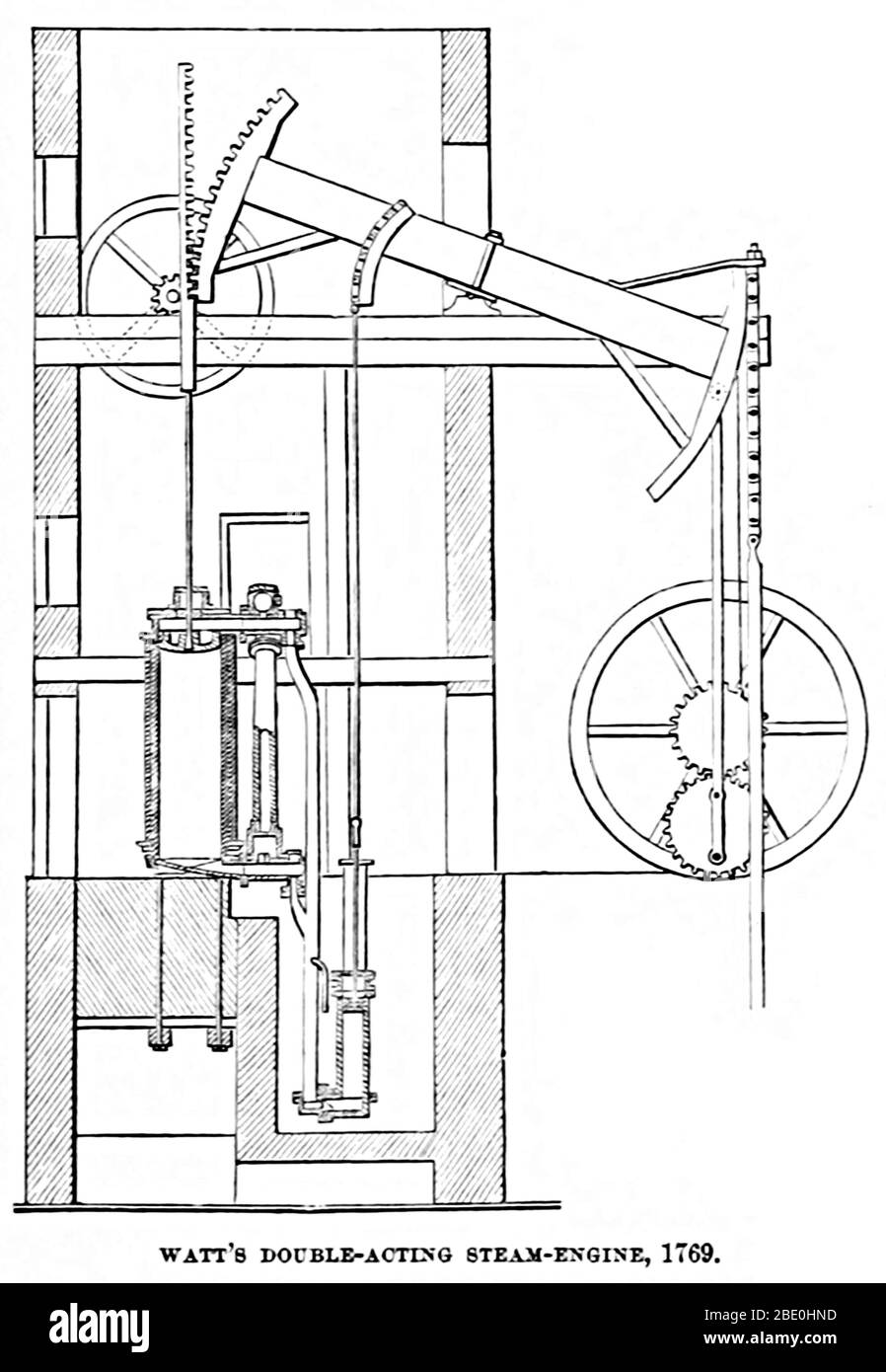 Watts' Double-acting steam engine. The Watt steam engine (alternatively known as the Boulton and Watt steam engine) was the first type of steam engine to make use of steam at a pressure just above atmospheric to drive the piston helped by a partial vacuum. Improving on the design of the 1712 Newcomen engine, the Watt steam engine, developed sporadically from 1763 to 1775, was the next great step in the development of the steam engine. Watt's two most important improvements were the separate condenser and rotary motion. Illustration from A review of American progress by Theodore Dwight Woolsey, Stock Photohttps://www.alamy.com/image-license-details/?v=1https://www.alamy.com/watts-double-acting-steam-engine-the-watt-steam-engine-alternatively-known-as-the-boulton-and-watt-steam-engine-was-the-first-type-of-steam-engine-to-make-use-of-steam-at-a-pressure-just-above-atmospheric-to-drive-the-piston-helped-by-a-partial-vacuum-improving-on-the-design-of-the-1712-newcomen-engine-the-watt-steam-engine-developed-sporadically-from-1763-to-1775-was-the-next-great-step-in-the-development-of-the-steam-engine-watts-two-most-important-improvements-were-the-separate-condenser-and-rotary-motion-illustration-from-a-review-of-american-progress-by-theodore-dwight-woolsey-image352826473.html
Watts' Double-acting steam engine. The Watt steam engine (alternatively known as the Boulton and Watt steam engine) was the first type of steam engine to make use of steam at a pressure just above atmospheric to drive the piston helped by a partial vacuum. Improving on the design of the 1712 Newcomen engine, the Watt steam engine, developed sporadically from 1763 to 1775, was the next great step in the development of the steam engine. Watt's two most important improvements were the separate condenser and rotary motion. Illustration from A review of American progress by Theodore Dwight Woolsey, Stock Photohttps://www.alamy.com/image-license-details/?v=1https://www.alamy.com/watts-double-acting-steam-engine-the-watt-steam-engine-alternatively-known-as-the-boulton-and-watt-steam-engine-was-the-first-type-of-steam-engine-to-make-use-of-steam-at-a-pressure-just-above-atmospheric-to-drive-the-piston-helped-by-a-partial-vacuum-improving-on-the-design-of-the-1712-newcomen-engine-the-watt-steam-engine-developed-sporadically-from-1763-to-1775-was-the-next-great-step-in-the-development-of-the-steam-engine-watts-two-most-important-improvements-were-the-separate-condenser-and-rotary-motion-illustration-from-a-review-of-american-progress-by-theodore-dwight-woolsey-image352826473.htmlRM2BE0HND–Watts' Double-acting steam engine. The Watt steam engine (alternatively known as the Boulton and Watt steam engine) was the first type of steam engine to make use of steam at a pressure just above atmospheric to drive the piston helped by a partial vacuum. Improving on the design of the 1712 Newcomen engine, the Watt steam engine, developed sporadically from 1763 to 1775, was the next great step in the development of the steam engine. Watt's two most important improvements were the separate condenser and rotary motion. Illustration from A review of American progress by Theodore Dwight Woolsey,
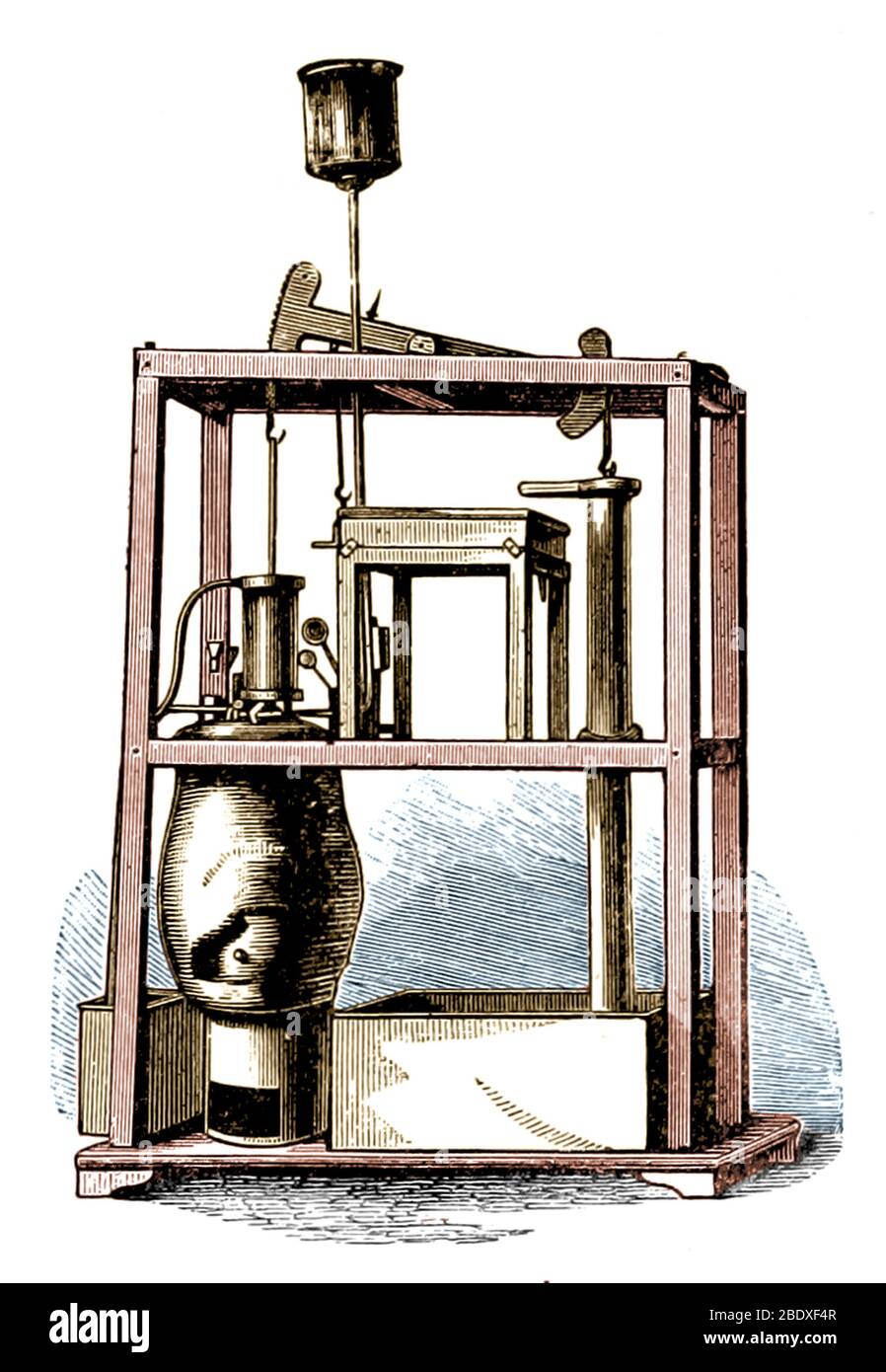 Newcomen's Steam Engine, 18th Century Stock Photohttps://www.alamy.com/image-license-details/?v=1https://www.alamy.com/newcomens-steam-engine-18th-century-image352780535.html
Newcomen's Steam Engine, 18th Century Stock Photohttps://www.alamy.com/image-license-details/?v=1https://www.alamy.com/newcomens-steam-engine-18th-century-image352780535.htmlRM2BDXF4R–Newcomen's Steam Engine, 18th Century
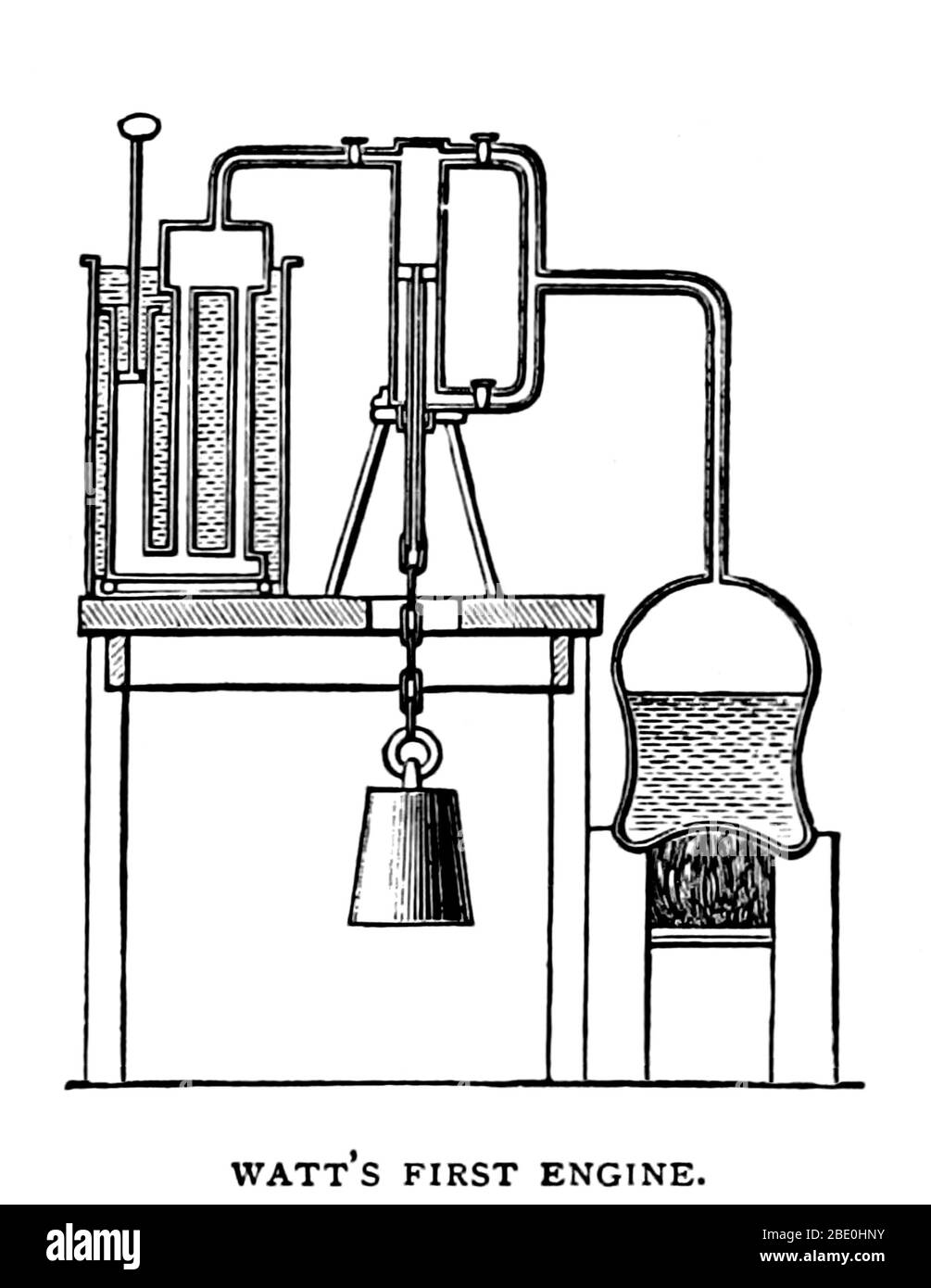 Watts' first steam engine illustration taken from page 114 of 'George Square, Glasgow; and the lives of those whom its statues commemorate, etc' by Thomas (of Glascow) Somerville, 1891. The Watt steam engine (alternatively known as the Boulton and Watt steam engine) was the first type of steam engine to make use of steam at a pressure just above atmospheric to drive the piston helped by a partial vacuum. Improving on the design of the 1712 Newcomen engine, the Watt steam engine, developed sporadically from 1763 to 1775, was the next great step in the development of the steam engine. Watt's two Stock Photohttps://www.alamy.com/image-license-details/?v=1https://www.alamy.com/watts-first-steam-engine-illustration-taken-from-page-114-of-george-square-glasgow-and-the-lives-of-those-whom-its-statues-commemorate-etc-by-thomas-of-glascow-somerville-1891-the-watt-steam-engine-alternatively-known-as-the-boulton-and-watt-steam-engine-was-the-first-type-of-steam-engine-to-make-use-of-steam-at-a-pressure-just-above-atmospheric-to-drive-the-piston-helped-by-a-partial-vacuum-improving-on-the-design-of-the-1712-newcomen-engine-the-watt-steam-engine-developed-sporadically-from-1763-to-1775-was-the-next-great-step-in-the-development-of-the-steam-engine-watts-two-image352826487.html
Watts' first steam engine illustration taken from page 114 of 'George Square, Glasgow; and the lives of those whom its statues commemorate, etc' by Thomas (of Glascow) Somerville, 1891. The Watt steam engine (alternatively known as the Boulton and Watt steam engine) was the first type of steam engine to make use of steam at a pressure just above atmospheric to drive the piston helped by a partial vacuum. Improving on the design of the 1712 Newcomen engine, the Watt steam engine, developed sporadically from 1763 to 1775, was the next great step in the development of the steam engine. Watt's two Stock Photohttps://www.alamy.com/image-license-details/?v=1https://www.alamy.com/watts-first-steam-engine-illustration-taken-from-page-114-of-george-square-glasgow-and-the-lives-of-those-whom-its-statues-commemorate-etc-by-thomas-of-glascow-somerville-1891-the-watt-steam-engine-alternatively-known-as-the-boulton-and-watt-steam-engine-was-the-first-type-of-steam-engine-to-make-use-of-steam-at-a-pressure-just-above-atmospheric-to-drive-the-piston-helped-by-a-partial-vacuum-improving-on-the-design-of-the-1712-newcomen-engine-the-watt-steam-engine-developed-sporadically-from-1763-to-1775-was-the-next-great-step-in-the-development-of-the-steam-engine-watts-two-image352826487.htmlRM2BE0HNY–Watts' first steam engine illustration taken from page 114 of 'George Square, Glasgow; and the lives of those whom its statues commemorate, etc' by Thomas (of Glascow) Somerville, 1891. The Watt steam engine (alternatively known as the Boulton and Watt steam engine) was the first type of steam engine to make use of steam at a pressure just above atmospheric to drive the piston helped by a partial vacuum. Improving on the design of the 1712 Newcomen engine, the Watt steam engine, developed sporadically from 1763 to 1775, was the next great step in the development of the steam engine. Watt's two
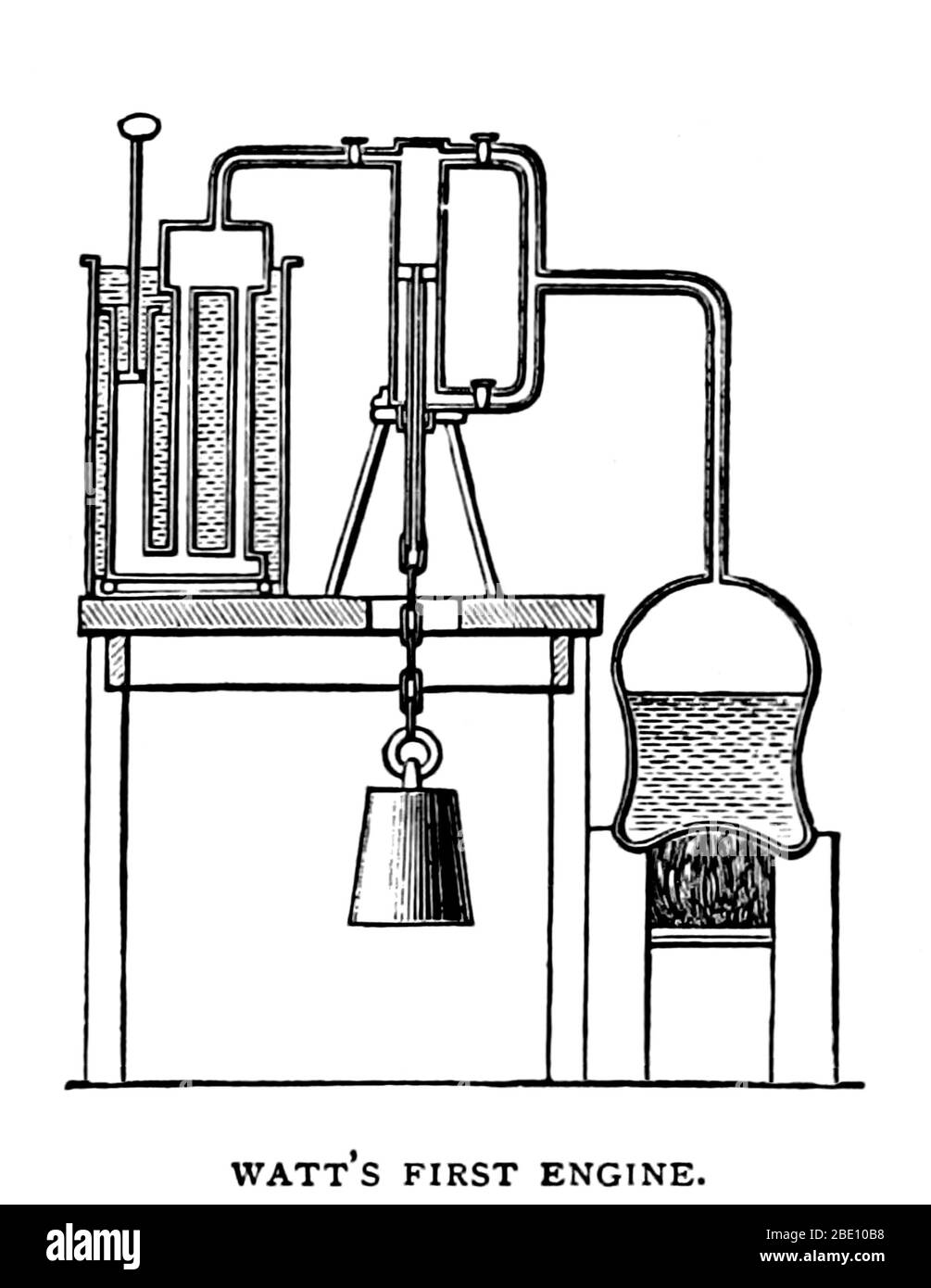 Watts' first steam engine illustration taken from page 114 of 'George Square, Glasgow; and the lives of those whom its statues commemorate, etc' by Thomas (of Glascow) Somerville, 1891. The Watt steam engine (alternatively known as the Boulton and Watt steam engine) was the first type of steam engine to make use of steam at a pressure just above atmospheric to drive the piston helped by a partial vacuum. Improving on the design of the 1712 Newcomen engine, the Watt steam engine, developed sporadically from 1763 to 1775, was the next great step in the development of the steam engine. Watt's two Stock Photohttps://www.alamy.com/image-license-details/?v=1https://www.alamy.com/watts-first-steam-engine-illustration-taken-from-page-114-of-george-square-glasgow-and-the-lives-of-those-whom-its-statues-commemorate-etc-by-thomas-of-glascow-somerville-1891-the-watt-steam-engine-alternatively-known-as-the-boulton-and-watt-steam-engine-was-the-first-type-of-steam-engine-to-make-use-of-steam-at-a-pressure-just-above-atmospheric-to-drive-the-piston-helped-by-a-partial-vacuum-improving-on-the-design-of-the-1712-newcomen-engine-the-watt-steam-engine-developed-sporadically-from-1763-to-1775-was-the-next-great-step-in-the-development-of-the-steam-engine-watts-two-image352834812.html
Watts' first steam engine illustration taken from page 114 of 'George Square, Glasgow; and the lives of those whom its statues commemorate, etc' by Thomas (of Glascow) Somerville, 1891. The Watt steam engine (alternatively known as the Boulton and Watt steam engine) was the first type of steam engine to make use of steam at a pressure just above atmospheric to drive the piston helped by a partial vacuum. Improving on the design of the 1712 Newcomen engine, the Watt steam engine, developed sporadically from 1763 to 1775, was the next great step in the development of the steam engine. Watt's two Stock Photohttps://www.alamy.com/image-license-details/?v=1https://www.alamy.com/watts-first-steam-engine-illustration-taken-from-page-114-of-george-square-glasgow-and-the-lives-of-those-whom-its-statues-commemorate-etc-by-thomas-of-glascow-somerville-1891-the-watt-steam-engine-alternatively-known-as-the-boulton-and-watt-steam-engine-was-the-first-type-of-steam-engine-to-make-use-of-steam-at-a-pressure-just-above-atmospheric-to-drive-the-piston-helped-by-a-partial-vacuum-improving-on-the-design-of-the-1712-newcomen-engine-the-watt-steam-engine-developed-sporadically-from-1763-to-1775-was-the-next-great-step-in-the-development-of-the-steam-engine-watts-two-image352834812.htmlRM2BE10B8–Watts' first steam engine illustration taken from page 114 of 'George Square, Glasgow; and the lives of those whom its statues commemorate, etc' by Thomas (of Glascow) Somerville, 1891. The Watt steam engine (alternatively known as the Boulton and Watt steam engine) was the first type of steam engine to make use of steam at a pressure just above atmospheric to drive the piston helped by a partial vacuum. Improving on the design of the 1712 Newcomen engine, the Watt steam engine, developed sporadically from 1763 to 1775, was the next great step in the development of the steam engine. Watt's two